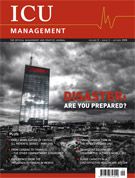ICU Volume 9 - Issue 3 - Autumn 2009
- ICU
- 20/09/2009
COVER STORY - Disaster: Are You Prepared? MATRIX FEATURES - Series on Early Mobilisation of Critically Ill Patients Part One: Screening and Saf
READ MOREDISASTER: A heading that covers a myriad of problems, reactions, plans that have failed to come to fruition, sometimes natural, uncontrollable- other times purposeful and deliberate. Whether it be a natural eventhurricane, earthquake, flood or wild fire; an accidentplane crash, bridge collapse, ferry capsizing; or an intentional act- bomb explosion,...
READ MOREInfections caught in hospital are costing the Australian healthcare system more than 850,000 lost bed days, according to a new study by Queensland University of Technology. Associate Professor Nick Graves, from QUT's Institute of Health and Biomedical Innovation, said there were 175,153 cases where patients had acquired an infection during their...
READ MORENew World Health Organisation data published in the Lancet will shed new light on two leading causes of pneumonia, the world's leading killer of children under age 5, both globally and within specific countries. The results, which are the first ever available at the country level, are expected to serve as a clarion call to developing country governments...
READ MOREThe new world, new technology and new means of transport not only make global cooperation easier, but also the distribution of new diseases. The new influenza A virus variant (H1N1)v, which has rapidly spread worldwide, offers new possibilities for cooperation and an unique opportunity to plan a mutual tactic against the pandemic. A new influenza...
READ MOREPart Two: From cardiac to thoracic - the other compartment syndrome In the last issue of ICU Management, we featured PART ONE of this article, which discussed Pelvic Compartment Syndrome, Abdominal Compartment Syndrome (ACS) and intra-abdominal pressure measurement. In the second part of this article, we will focus on the remaining compartment...
READ MOREThe average intensive care unit (ICU) room is approximately 400 square feet. This space often seems quite small when filled with monitoring devices, beds, ventilators, and pumps necessary for proper patient care. In the transport environment, space is often a fraction of that of a hospital. Ambulances of all types must be configured to transport patients...
READ MOREBackground: Natural Disasters Mexico has suffered from more than its' fair share of disasters. In 1985, an earthquake struck Mexico City killing more than 10 000 inhabitants and destroying or disabling the most important high care hospitals. Following the earthquake, Mexican society showed a deep sense of humanity, solidarity and awareness about...
READ MOREEuroanaesthesia 2009, the annual scientific meeting of the European Society of Anaesthesiology, took place at the beginning of June in the Milano Convention Centre, the largest convention centre in Italy. Over its four days, around 5,500 delegates attended. Most participants pre-registered, but around 15% registered on the day. Euroanaesthesia...
READ MORE
COVER STORY - Disaster: Are You Prepared? MATRIX FEATURES - Series on Early Mobilisation of Critically Ill Patients Part One: Screening and Saf
READ MORE
Zvi Stern of the Hadassah Hebrew University Medical Center in Jerusalem, Israel, and colleagues report that resident physicians, colloquially...
READ MORE